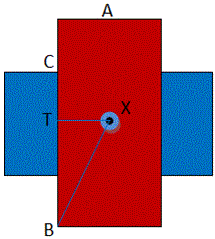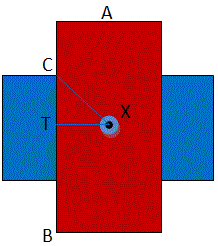Part of a toy is made up of a block on top of another block. Both blocks are 6 cm by 8 cm. The top block rotates about its centre, X.
In the diagram above, A is the midpoint of a shorter side of the top block; B is a corner of the top block; and C is a point on the edge of both rectangles; and.
The points A, B and C all move on a circle as the top block rotates. What are the radii of these circles?
Solution
The radius of the circle that A is on is AX. This is half of the length of the top block. So this radius is 4 cm.
The radius of the circle that B is on is BX. This is shown in the diagram.

We have also put in the point T that is the midpoint of the side of the block. Now XT = 3 and BT = 4. Triangle AXT is a right angled triangle with side lengths 3, 4 and 5. So BX = 5 and the radius we want here is 5 cm long.
The radius of the circle that C is on is CX. This is shown in the diagram.

Here CTX is a right angled triangle with CT = 3 because it is half of the side length of the bottom block. By Pythagoras’ Theorem, CX2 = CT2 + TX2, so CX2 = 32 + 32 = 18. So CX = √18 and this is approximately 4.36 cm.
Extension
The top block turns completely once. In that time, how many times is
- A over an edge of the bottom block?
- B over an edge of the bottom block?
- C over an edge of the bottom block?
